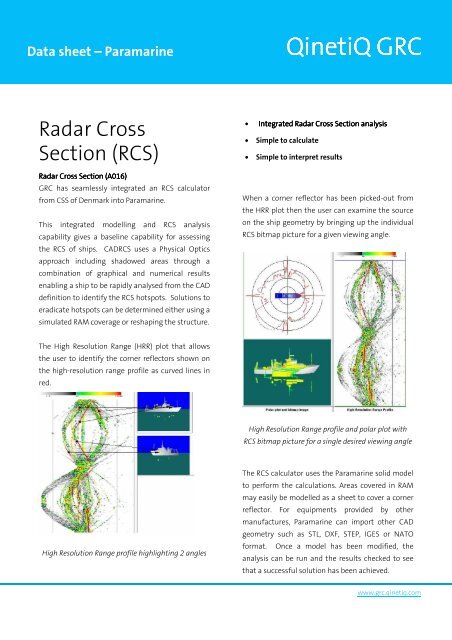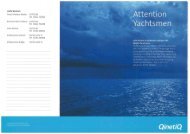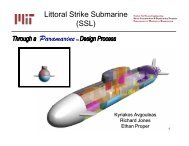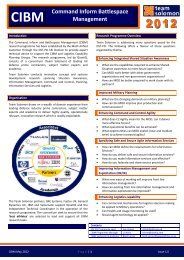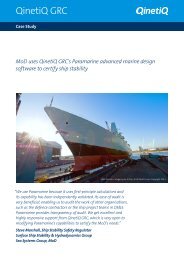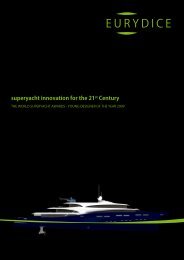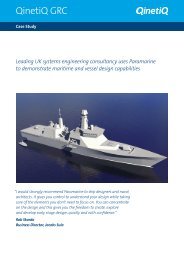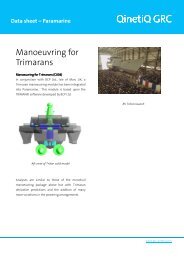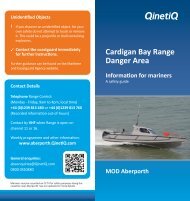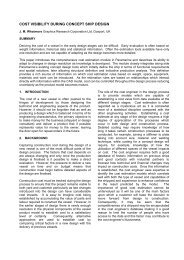Radar Cross Section - QinetiQ GRC
Radar Cross Section - QinetiQ GRC
Radar Cross Section - QinetiQ GRC
You also want an ePaper? Increase the reach of your titles
YUMPU automatically turns print PDFs into web optimized ePapers that Google loves.
Data sheet – Paramarine<br />
<strong>QinetiQ</strong> <strong>GRC</strong><br />
<strong>Radar</strong> <strong>Cross</strong><br />
<strong>Section</strong> (RCS)<br />
<strong>Radar</strong> <strong>Cross</strong> <strong>Section</strong> (A016)<br />
<strong>GRC</strong> has seamlessly integrated an RCS calculator<br />
from CSS of Denmark into Paramarine.<br />
This integrated modelling and RCS analysis<br />
capability gives a baseline capability for assessing<br />
the RCS of ships. CADRCS uses a Physical Optics<br />
approach including shadowed areas through a<br />
combination of graphical and numerical results<br />
enabling a ship to be rapidly analysed from the CAD<br />
definition to identify the RCS hotspots. Solutions to<br />
eradicate hotspots can be determined either using a<br />
simulated RAM coverage or reshaping the structure.<br />
• Integrated <strong>Radar</strong> <strong>Cross</strong> <strong>Section</strong> analysis<br />
• Simple to calculate<br />
• Simple to interpret results<br />
When a corner reflector has been picked-out from<br />
the HRR plot then the user can examine the source<br />
on the ship geometry by bringing up the individual<br />
RCS bitmap picture for a given viewing angle.<br />
The High Resolution Range (HRR) plot that allows<br />
the user to identify the corner reflectors shown on<br />
the high-resolution range profile as curved lines in<br />
red.<br />
High Resolution Range profile and polar plot with<br />
RCS bitmap picture for a single desired viewing angle<br />
High Resolution Range profile highlighting 2 angles<br />
The RCS calculator uses the Paramarine solid model<br />
to perform the calculations. Areas covered in RAM<br />
may easily be modelled as a sheet to cover a corner<br />
reflector. For equipments provided by other<br />
manufactures, Paramarine can import other CAD<br />
geometry such as STL, DXF, STEP, IGES or NATO<br />
format. Once a model has been modified, the<br />
analysis can be run and the results checked to see<br />
that a successful solution has been achieved.<br />
www.grc.qinetiq.com
Data sheet – Paramarine<br />
<strong>QinetiQ</strong> <strong>GRC</strong><br />
Solid model analysed by RCS<br />
Confidence in the RCS prediction by CADRCS has<br />
been gained through comparisons with ship<br />
measurements. This is backed up by the authors<br />
(Gert Lindqvist, CSS) fifteen years experience at the<br />
Danish Research Establishment (DDRE).<br />
The integration of CADRCS into Paramarine<br />
provides the user with a high quality prediction that<br />
works seamlessly with the vessels design definition.<br />
For further information, please contact:<br />
<strong>QinetiQ</strong> <strong>GRC</strong><br />
Haslar Marine Technology Park<br />
Haslar Road<br />
Gosport<br />
Hampshire PO12 2AG<br />
United Kingdom<br />
Tel +44 (0) 2392 334003<br />
www.grc.qinetiq.com<br />
© Copyright <strong>QinetiQ</strong> <strong>GRC</strong> 2009<br />
www.grc.qinetiq.com


